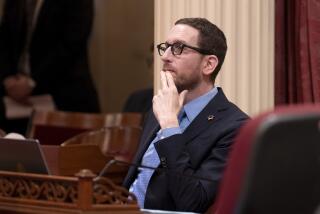Theme Parks Fighting Over Nuts, Bolts of Law
Unable to weaken a state bill last year regulating amusement parks, Disneyland, Universal Studios and other parks are now fighting to water down the rules that will put the new law into effect.
In a public meeting and a series of written comments, industry leaders have driven a big wedge between their view of what the rules should be and the regulations proposed by the state’s Division of Occupational Safety and Health.
Particularly divisive, say state officials and consumer groups, is determining what accidents must be reported publicly. The industry’s version is far weaker than the law intended, the measure’s author, Assemblyman Tom Torlakson (D-Antioch), said Wednesday.
The law, which calls for annual inspections of rides, safety guidelines and reporting of accidents, can’t be fully implemented until the rules are hashed out, a process regulators say could take until next fall.
The law was signed by the governor in October after a series of California amusement park accidents, most notably the Christmas Eve 1998 accident that killed a Disneyland patron.
According to minutes of a public meeting in January, the battle is shaping up over such issues as whether state engineers or company-hired inspectors perform the inspections of rides and whether parks can be fined for anything other than “willful and intentional violations” resulting in deaths or serious injuries.
But consumer advocates are most concerned about a part of the law requiring parks to report accidents in which injured patrons receive treatment beyond “ordinary first aid.” That requirement, advocates say, will let the public judge whether most accidents can be blamed on riders, as the industry contends.
Spokesmen for Disney and Universal declined to discuss their concerns over the proposed regulations, saying only that they will continue to work with the state on the new rules.
Discussions so far have been cordial, but “significant disagreement” exists between the industry and regulators on a wide range of issues, said Len Welsh, the occupational safety division’s acting deputy chief.
Disagreement Over Seriousness of Injuries
Disney and Universal have argued previously that their safety standards are far higher than those of other theme parks and that state inspectors won’t understand the workings of their unusual rides.
The industry also fears that minor mishaps--such as a sprained ankle suffered in a parking lot--would have to be reported along with serious accidents on rides.
Trying to clarify the language of the bill, regulators have proposed that any accident that causes “serious medical concern” must be reported. The requirement is designed to ensure that parks would disclose, say, an X-ray for broken bones even if no fractures were found.
Kathy Fackler of San Diego, who attended the January meeting as a consumer advocate, said she was dismayed when park officials instead argued for reporting requirements that are applied to workers injured on the job: death, loss of limbs and hospitalizations for more than 24 hours.
“Only about 2% of all amusement ride accidents require hospitalization,” Fackler said. “That’s where the parks are coming from. With one fell swoop they can eliminate 98% of the reports.”
She has studied the issue since her son lost part of his foot in a 1998 accident on a Disneyland roller coaster, Big Thunder Mountain Railroad.
Welsh said the industry’s interpretation of the reporting provision is so restrictive that parks could avoid disclosures when patrons suffer broken bones or cuts requiring stitches.
That outcome would be clearly at odds with Torlakson’s intent.
Torlakson said the “more than first aid” language in his bill was intended to create a standard at least as high as for traveling carnivals, which he said must report any accident in which an ambulance transports a victim.
“We did not intend for it to be only dismemberment, decapitation and death,” he said. “We thought it would be more helpful to the consumer to understand the whole range of accidents that can happen, and any trends in the parks.”
Torlakson said the law intends that initial ride inspections to establish “baseline” safety criteria would be performed by trained state employees or outside experts hired by the state--not the parks or manufacturers, as industry officials suggest.
While the law creates penalties of as much as $70,000 for willful safety violations at parks, it is intended to allow regulators to impose penalties for lesser but still “serious violations of safety,” he said. The industry is arguing for holding penalties to willful or grossly negligent violations.
Torlakson said he expected that adopting the rules would be a “long and challenging” process. But regulators will enforce the law’s intent, he said, “to reduce the tragedies and accidents that set California apart from the rest of the nation with a very bad track record.”
A 1997 study by state library researchers found that 10 patrons were killed on California amusement rides from 1973 through 1996, more than in any other state.
In case the rule-making process becomes stymied, Torlakson has introduced a bill this year that can be used to clarify the provisions of the law.
Safety Law’s Tortuous Path
While California has long regulated traveling carnivals, its powerful theme parks had convinced legislators that the permanent parks can police themselves. The industry has blocked numerous California and federal efforts for more than 30 years to regulate ride safety.
The law passed last year went through a tortuous path as it was constantly amended, sometimes to reflect the industry’s effort to reduce its impact, other times to beef it up.
The industry, for instance, fought to avoid outside inspections and reporting requirements. But the law that was adopted remained close to the intent of the original effort.
Torlakson’s effort was his second. He first proposed regulating the industry after a 1997 water-slide fatality in his district, but that bill died in a committee hearing in early 1998.
He revived the bill after the tourist’s death at Disneyland, which regulators blamed on the park’s inadequate training of an employee. Subsequent accidents, including the death of a disabled boy who fell from a ride at Paramount’s Great America in Santa Clara, intensified calls for statewide regulation.
More to Read
Inside the business of entertainment
The Wide Shot brings you news, analysis and insights on everything from streaming wars to production — and what it all means for the future.
You may occasionally receive promotional content from the Los Angeles Times.











